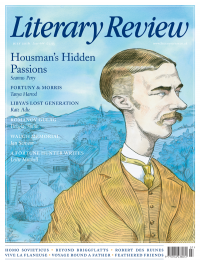Jay Parini
Getting into Character
Bellow’s People: How Saul Bellow Made Life into Art
By David Mikics
W W Norton 241pp £17.99
I met Saul Bellow several times, as he spent a fair part of his last years in Vermont and we had several friends in common. Once, at a dinner party in the 1980s, he arrived in high spirits, having just finished The Dean’s December. He talked rapidly and passionately about the ‘younger generation’, the Boomers (like myself) who had protested against the Vietnam War and now seemed to have lost their moral edge. In a fluster, I argued with him about Vietnam and the 1960s. I found him irascible and terribly condescending. His sense of paternal authority unsettled me: I didn’t trust it and I still don’t, although I find him wonderful to read – at least in his best work.
Bellow’s many voices stick in one’s mind. And these voices, emerging from the lips of eccentric and alluring characters, were not wholly invented. As David Mikics suggests in Bellow’s People – a breezy, highly readable and often entertaining study of some important figures in the author’s life – he drew on people he knew. The problem here, of course, is that every character in fiction is a composite; Mikics knows this, but he nevertheless persists in asking us to read behind the characters in the novels and see how they were based on figures (or experiences) from Bellow’s own life.
I don’t buy the wobbly premise of the book, but nevertheless I learned a lot from it about Bellow and – what other function does criticism have? – was driven to lift from the shelf my old copies of his books and reread a number of favourite passages. I was

Sign Up to our newsletter
Receive free articles, highlights from the archive, news, details of prizes, and much more.@Lit_Review
Follow Literary Review on Twitter
Twitter Feed
It wasn’t until 1825 that Pepys’s diary became available for the first time. How it was eventually decrypted and published is a story of subterfuge and duplicity.
Kate Loveman tells the tale.
Kate Loveman - Publishing Pepys
Kate Loveman: Publishing Pepys
literaryreview.co.uk
Arthur Christopher Benson was a pillar of the Edwardian establishment. He was supremely well connected. As his newly published diaries reveal, he was also riotously indiscreet.
Piers Brendon compares Benson’s journals to others from the 20th century.
Piers Brendon - Land of Dopes & Tories
Piers Brendon: Land of Dopes & Tories - The Benson Diaries: Selections from the Diary of Arthur Christopher Benson by Eamon Duffy & Ronald Hyam (edd)
literaryreview.co.uk
Of the siblings Gwen and Augustus John, it is Augustus who has commanded most attention from collectors and connoisseurs.
Was he really the finer artist, asks Tanya Harrod, or is it time Gwen emerged from her brother’s shadow?
Tanya Harrod - Cut from the Same Canvas
Tanya Harrod: Cut from the Same Canvas - Artists, Siblings, Visionaries: The Lives and Loves of Gwen and Augustus John by Judith Mackrell
literaryreview.co.uk